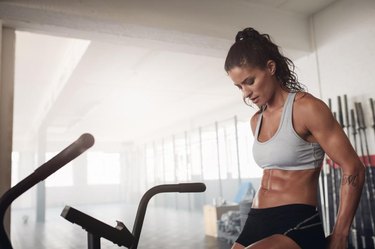
Churning your legs on a stationary bike is more likely to help you lose an extra belly bulge than crunching your abs. Exercise, especially cardio, helps you lose visceral fat that resides in the deep belly and gain lean muscle. A consistent program that weaves both steady-state riding and intervals into your week burns calories and stimulates fat-burning so you get slimmer
Related Reading
Video of the Day
Steady-State Riding
If you're new to exercise, the Arthritis Foundation suggests riding for five minutes three times a day. Build up to a regular routine of stationary cycling to lose weight that includes a minimum of 30 minutes of moderate-intensity cardio, five to six times per week. Do this moderate-intensity work by pedaling a stationary bike at an effort that raises your heart rate to between 50 percent and 70 percent of your maximum.
Video of the Day
Another way of determining workout intensity is by using the "talk test" suggested by the U.S. Department of Health and Human Services Physical Activity Guidelines for Americans . If you can talk but not sing, your workout can be considered moderate. If you need to take a breath every few words, then it's intense.
If you can't commit 30 straight minutes to stationary biking, you can break it up into 10-minute intervals and still gain benefit to your health and burn calories to help reduce belly fat.
Exercise Bike for Weight Loss
Using a stationary bike for weight loss means you have choices. Once you can manage regular moderate-paced riding, work a little harder at a few of your weekly pedaling sessions.
When you pedal your bike, increase the level or resistance you use at two of your workouts. Go for 20 to 30 minutes at this higher intensity that raises your heart rate to about 75 to 85 percent of your maximum. You'll be left huffing and puffing and build up quite a sweat, but the effort will be worth it when you see your girth go down.
Tip
An easy way to estimate your maximum heart rate is to subtract your age from 220. For example, if you're 45 years old, your maximum heart rate would be 175 (220 - 45 = 175). If you want a more precise evaluation, seek out a gym that performs metabolic testing.
Perform Interval Training
Steady-state exercise gets you started with fat loss, while high-intensity intervals turn up your fat-burning engine. The American Council on Exercise suggests that interval training burns more calories in less time and increases the production of fat-burning hormones.
Every workout you do shouldn't involve HIIT, or high-intensity interval training. Consider doing two to three HIIT workouts on the bike per week, using these in the place of steady high-intensity workouts. Other days should still consist of moderate-intensity pedaling, or you'll risk burn out.
To perform intervals on a stationary bike:
Step 1: Warm Up
Warm up for five to 10 minutes at a low resistance. Just feel your joints awaken and blood flow increase. Your heart rate will also start to rise, but will not be anywhere near your maximum.
Step 2: Hit the Interval
Pedal one to two minutes with a higher resistance and intense pedal-stroke effort as you can. Feel your heart beat rise, eventually reaching a point where you feel nearly breathless.
Step 3: Recover
Return to an easy effort of pedaling for one to two minutes. Feel your heart rate recover and your breath rate return to a more controlled level.
Step 4: Alternate Intensities
Alternate the high-intensity and low-intensity intervals 10 to 15 times total. One of the benefits of high-intensity intervals is that they sizzle fat in a relatively short workout.
Step 5: Cool Down
Conclude your workout with three to five minutes of pedaling easily as a cool down.
Tip
Intervals can take on many different configurations. If one to two minutes is too long, perform 30-second intervals. Or to add a new challenge, make your intervals of intense work last five to 10 minutes with two minutes of easier effort between them.
Read more: 5 Myths About HIIT Debunked
- U.S. Department of Health and Human Services: Physical Activity Guidelines for Americans, 2nd Edition: Chapter 4. Adult Fitness
- University of New Mexico: The Talk Test
- ACE Fitness: Steady State Vs. Interval Training: Which One Is Best for Your Clients?
- Arthritis Foundation: Benefits of Stationary Cycling